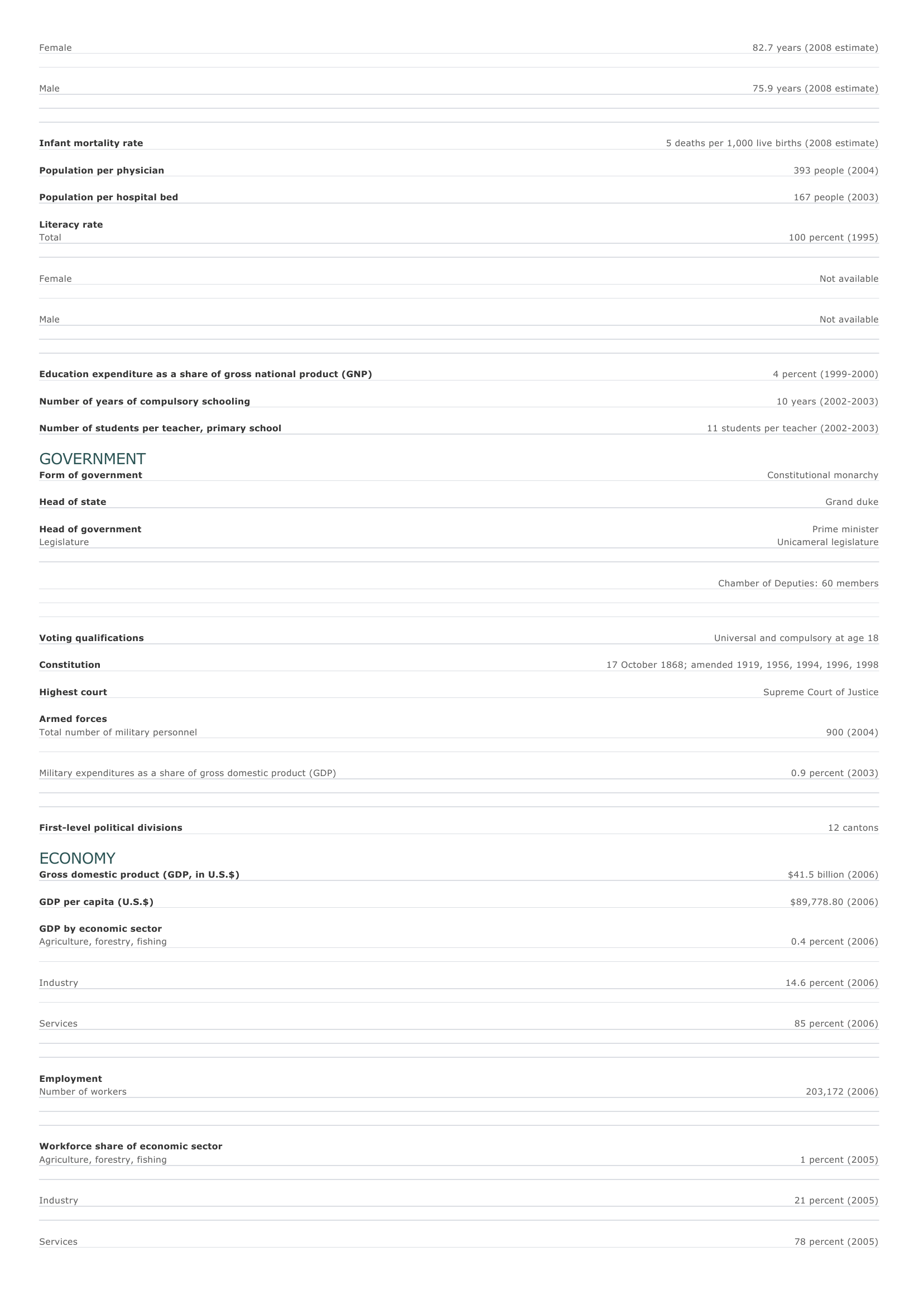Luxembourg Facts and Figures. BASIC FACTS Official name Grand Duchy of Luxembourg Capital Luxembourg Area 2,586 sq km 998 sq mi PEOPLE Population 486,006 (2008 estimate) Population growth Population growth rate 1.19 percent (2008 estimate) Projected population in 2025 586,296 (2025 estimate) Projected population in 2050 720,603 (2050 estimate) Population density Urban/rural distribution Share urban Share rural 188 persons per sq km (2008 estimate) 487 persons per sq mi (2008 estimate) 92 percent (2003 estimate) 8 percent (2003 estimate) Largest cities, with population Luxembourg 83,800 (2007 estimate) E sch 27,900 (2004 estimate) Differdange 18,900 (2004 estimate) D udelange 17,500 (2003 estimate) Pétange 14,400 (2004 estimate) Ethnic groups Celtic base (with French and German blend) 75 percent Guest workers and residents from other European countries, including Portugal and Italy 25 percent Languages Luxembourgisch, German, French, English Religious affiliations Roman Catholic 94 percent Protestant 2 percent Nonreligious 3 percent O ther 1 percent HEALTH AND EDUCATION Life expectancy Total 79.2 years (2008 estimate) Female 82.7 years (2008 estimate) Male 75.9 years (2008 estimate) Infant mortality rate 5 deaths per 1,000 live births (2008 estimate) Population per physician 393 people (2004) Population per hospital bed 167 people (2003) Literacy rate Total 100 percent (1995) Female Not available Male Not available Education expenditure as a share of gross national product (GNP) Number of years of compulsory schooling Number of students per teacher, primary school 4 percent (1999-2000) 10 years (2002-2003) 11 students per teacher (2002-2003) GOVERNMENT Form of government Head of state Head of government Legislature Constitutional monarchy Grand duke Prime minister Unicameral legislature Chamber of Deputies: 60 members Voting qualifications Constitution Highest court Armed forces Total number of military personnel Military expenditures as a share of gross domestic product (GDP) First-level political divisions Universal and compulsory at age 18 17 October 1868; amended 1919, 1956, 1994, 1996, 1998 Supreme Court of Justice 900 (2004) 0.9 percent (2003) 12 cantons ECONOMY Gross domestic product (GDP, in U.S.$) $41.5 billion (2006) GDP per capita (U.S.$) $89,778.80 (2006) GDP by economic sector Agriculture, forestry, fishing 0.4 percent (2006) I ndustry 14.6 percent (2006) Services 85 percent (2006) Employment Number of workers 203,172 (2006) Workforce share of economic sector Agriculture, forestry, fishing 1 percent (2005) I ndustry 21 percent (2005) Services 78 percent (2005) Unemployment rate 4.8 percent (2004) National budget (U.S.$) Total revenue $15,716 million (2006) Total expenditure $14,755 million (2006) Monetary unit* 1 euro (EUR), consisting of 100 cents
*The Luxembourg franc (LuxF) became linked to the EU single currency, the euro (EUR), on 1 January 1999 at a fixed rate of 40.3399 to 1 euro (EUR). Euro coins and bills replaced the Luxembourg franc as the national currency on January 1, 2002. Major trade partners for exports Germany, France, Belgium, United Kingdom, and Italy Major trade partners for imports Belgium, Germany, France, Taiwan, and United States ENERGY, COMMUNICATIONS, AND TRANSPORTATION Electricity production Electricity from thermal sources Electricity from hydroelectric sources Electricity from nuclear sources Electricity from geothermal, solar, and wind sources Number of radios per 1,000 people 94.40 percent (2003 estimate) 2.47 percent (2003 estimate) 0 percent (2003 estimate) 3.13 percent (2003 estimate) 396 (2000 estimate) Number of telephones per 1,000 people 535 (2005) Number of televisions per 1,000 people 601 (2000 estimate) Number of Internet hosts per 10,000 people 625 (2003) Daily newspaper circulation per 1,000 people 327 (1996) Number of motor vehicles per 1,000 people 729 (2004) Paved road as a share of total roads 100 percent (2004) SOURCES Basic Facts and People sections Area data are from the statistical bureaus of individual countries. Population, population growth rate, and population projections are from the United States Census Bureau, International Programs Center, International Data Base (IDB) (www.census.gov). Urban and rural population data are from the Food and Agriculture Organization (FAO) of the United Nations (UN), FAOSTAT database (www.fao.org). Largest cities population data and political divisions data are from the statistical bureaus of individual countries. Ethnic divisions and religion data are largely from the latest Central Intelligence Agency (CIA) World Factbook and from various country censuses and reports. Language data are largely from the Ethnologue, Languages of the World, Summer Institute of Linguistics International (www.sil.org). Health and Education section Life expectancy and infant mortality data are from the United States Census Bureau, International Programs Center, International database (IDB) (www.census.gov). Population per physician and population per hospital bed data are from the World Health Organization (WHO) (www.who.int). Education data are from the United Nations Educational, Scientific and Cultural Organization (UNESCO) database (www.unesco.org). Government section Government, independence, legislature, constitution, highest court, and voting qualifications data are largely from various government Web sites, the latest Europa World Yearbook, and the latest Central Intelligence Agency (CIA) World Factbook. The armed forces data is from Military Balance. Economy section Gross domestic product (GDP), GDP per capita, GDP by economic sectors, employment, and national budget data are from the World Bank database (www.worldbank.org). Monetary unit, agriculture, mining, manufacturing, exports, imports, and major trade partner information is from the statistical bureaus of individual countries, latest Europa World Yearbook, and various United Nations and International Monetary Fund (IMF) publications. Energy, Communication, and Transportation section Electricity information is from the Energy Information Administration (EIA) database (www.eia.doe.gov). Radio, telephone, television, and newspaper information is from the United Nations Educational, Scientific and Cultural Organization (UNESCO) database (www.unesco.org). Internet hosts, motor vehicles, and road data are from the World Bank database (www.worldbank.org). Note Figures may not total 100 percent due to rounding. Microsoft ® Encarta ® 2009. © 1993-2008 Microsoft Corporation. All rights reserved.








